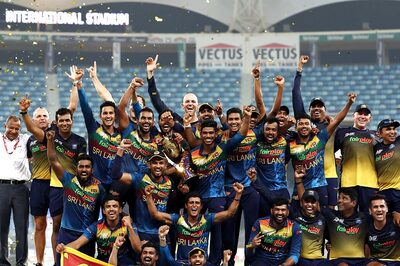
views
Types of Neckties
Standard The most common type of tie is a necktie, which includes any traditional long tie using knots that vary from the simplest to an Oriental or Windsor style. Depending on the exact tie design, the width varies from 2 inches (5.1 cm) to 6 inches (15 cm) of fabric. The standard tie is also called the “regular” or “straight” tie because all other necktie designs start with this classic. The standard tie became synonymous with the Langsdorf tie, a silk tie with an “on the bias” weave. The Langsdorf was created in 1922 by Tommy Langsdorf in New York City and is called the common necktie today.
Skinny These ties are typically no longer than 2.5 inches wide. They came of age in the Mad Men era of the 1950s and 1960s, but you may associate them with 1980s pop groups most of all. Skinny ties pair best with a slim-fit suit or a shirt underneath a sweater.
Kipper: The Kipper tie is known for its wider shape and became a well-known fashion choice in the 1960s and 1970s. Kippers usually come in bright colors and unique patterns that are stylish all on their own. A Kipper tie represents a shift from conservative to unconventional styles and is ideal for anyone who loves to be fashionable and retro.
Seven Fold This elegant tie is formed from one piece of silk that is folded 7 times. The amount of fabric means the seven-fold tie looks thicker than other similar styles. Seven-fold ties look smart as part of a formal event or business wear rather than as an everyday tie.
Sailor A Sailor tie resembles the tie on a sailor’s uniform, so it has a whimsical old-world quality to it. Also called a square knot tie, it’s tightly knotted in a scarf style and worn lower than a traditional tie knot. EXPERT TIP Kalee Hewlett Kalee Hewlett Image Consultant Kalee Hewlett is a Celebrity Stylist & Confidence Coach with almost two decades of experience helping clients build confidence and ‘dress for success.' She works with her clients to transform their sense of self 'from the inside out’ by merging her expertise in image consulting with Neuro-Linguistic Programming. Kalee’s work is rooted in science, style, and the understanding that ‘identity is destiny'. She uses her own methodology and Style To Success Strategy to create positive identity shifts. Kalee is a fashion TV host and appears regularly on QVC UK sharing her fashion expertise. She also was appointed as the head judge and host of Fashion One Network’s 6-part TV show 'Design Genius.’ Kalee Hewlett Kalee Hewlett Image Consultant Women too can wear neckties in their own unique style. Avoid wearing a necktie with anything other than a collared shirt or blouse. Try fastening the necktie once and having the loose ends hang; fasten twice to create a mini knot design; or fasten into a cute, neat bow.
Types of Bow Ties
Traditional Bow tie When you can’t decide on a necktie, a [Tie-a-Bow-Tie|bow tie] is a quaint fashion choice that works for more than tuxedos. It fastens around the neck and is adjustable via a buckle or clip. Usually made from silk or cotton, a bow tie consists of two loops that form a symmetrical knot in the shape of a bow. Bow ties are traditionally worn with tuxedos for “black tie” events, but they come in a variety of colors, materials, and patterns for any type of wear. A self-tied bow tie is a quick and easy substitute that can still be adjusted when worn. If you’re not in the mood to do anything, get a clip-on bow tie that goes on and off in a (literal) snap.
Western This rugged variation of a bow tie is known as a “string tie,” due to its long, thin, and pointed shape. You’d tie it in an actual bow so the end pieces both hang down. A western bow tie pairs well with any cowboy-inspired outfit you can think of for your next event.
Alternative Types of Ties
Bolo The tie most associated with the Old West on the list is the Bolo tie. It consists of a braided leather cord with tips and features an ornamental focal point where a traditional tie knot would be. Bolo ties are a favorite for an Americana look. If you’re in the mood for a cowboy hat or cowboy boots, a bolo tie will complete your stylish Western look.
Cravat Cravats are known for their loose knots and flowy fabric. [Choose-a-Tie|choose a tie] like this if you want an aristocratic dressy look that Oscar Wilde would be proud of. The Cravat originated from the French, who themselves copied a group of 17th-century Croatian mercenaries. Cravats are perfect for special events where you’d like to stand out with a classy vintage vibe. [Wear-a-Cravat|Wear a cravat] with a morning suit or a dinner jacket for the ultimate distinguished look.
Ascot A close relation to the cravat, the ascot is a more casual version worn with a simple knot and tucked into a shirt. Ascots work for semi-formal events where you want the look of a slightly less formal cravat.
Neckerchief This necktie alternative comprises a large square cotton fabric worn around the neck. Cowboys first wore neckerchiefs as a bandana, as did Boy Scouts and sailors, to keep their neck area free from dirt and grime. These days, neckerchiefs are worn in a smaller shape beneath the collar with a visible knot. It can also be worn to the side or back to look similar to an ascot.
Stock A stock tie consists of one pre-sewn piece of long fabric without folds. It slits in the center of the back portion for tying. The hunting stock variation uses a stock pin to stay in place. They’re related to both the ascot and cravat and are the pinnacle of style for vintage-ready style makers.
Clip On A clip-on tie can save the day when you don’t have time to worry about what knot to attempt. It comes in all shapes, widths, and lengths and clips onto most short collars.
Types of tie patterns
Solid Solid ties are as traditional as ties come. They feature one color that pairs well with a corresponding solid color or patterned shirt. The most popular solid tie color is dark or navy blue, which fits in with a variety of looks. However, if you’re wearing a subtle suit, a bright tie can sometimes help the whole look pop.
Patterned There are a wide variety of patterned ties, including stripes, dots, and plaid. You can also have fun making a bold statement when you go for lesser-known patterns, like florals and novelty ties. Striped: Striped tie patterns differ by color, size, and number of stripes. They come in a few forms, including the American stripe, which runs downward from the right shoulder to the left side. They give off an “Ivy League” look and pair well with a shirt of the opposite color. British stripes run opposite to their American counterpart and aim downward from the left shoulder to the right side. Repp stripe ties can run in either direction, but use a thicker, more textured pattern. Striped ties pair well with a solid, checkered, or barely-there striped shirt for a regal look. Dotted: A necktie with dots can turn any average suit into something playful. They come in a traditional polka dot, inspired by the popularity of polka dancing in the 19th century. Polka dot ties usually feature small white dots on a dark background. Pin dot ties have even tinier white dots that provide a more understated look. Whatever size dot your tie has, they wear well with striped or checkered shirts of a corresponding color. Plaid: Plaid ties focus on stipes that interlock using a variation of colors and widths. They’re also called tartan ties since they’re inspired by kilts worn in the Scottish Highlands. Tune into your inner Scotsman by wearing a plaid tie with a white shirt and wool blazer. Paisley: These artful tie designs originated in Persia and are known for their swirling teardrop pattern. They’re named after the Scottish town of Paisley, which made the ties during the 19th century. Your paisley tie can look as laid-back or vivid as you like, depending on how muted or multicolored the tones are. Novelty: When you’re in a fun mood, there is a selection of novelty ties you can go with. From a colorful floral design to offbeat images like palm trees or panda bears, novelty ties are ready for any trailblazing, one-of-a-kind look you have in mind. Sometimes, a club tie also falls under novelty ties because they highlight the logo or insignia of a specific club, society, or organization. Foulard: A Foulard tie consists of a small repeating pattern and is typically made from silk. It derives from the French word for “silk neckerchief.” This design doesn’t come across as overbearing or loud and has been a favorite sold by Brooks Brothers for the last century. Macclesfield: This tie is similar to a Foulard but doesn’t require a completely symmetrical pattern. It’s named after the English town of Macclesfield, once famous for its silk production. The geometric designs are typically woven in and offer a distinguished look in colors like white, blue, or silver.
What types of ties are in style?
Patterned silk ties These vibrant conversation-starting ties have become quite popular since people emerged from the pandemic lockdown ready to show off their styles. Several British brands have featured a patterned [Clean-a-Silk-Tie|silk tie] in their recent collections. For a more subtle choice, go for a grenadine tie of textured, woven silk that may be a good first step.
Knitted ties The texture of a knitted tie is ideal for autumn, winter, and holiday wear due to its warm and cozy feel. The great news about knitted ties is that they often appear in solid colors, so can look as subdued as you like.
Cashmere ties Make life fashionable through the winter season altogether with a cashmere tie that exudes luxury. It works as a charming focal point for any winter suit and sweater combination this holiday season.
Types of Ties FAQs
How do you tie a tie? To [Tie-a-Tie|tie a tie] with a [Tie-a-Windsor-Knot|Windsor knot], place the tie around your neck. The length of the wide end should equal two-thirds of the length of the entire tie. Cross the wide end over the top, leaving about 4 inches (10 cm) to 6 inches (15 cm) on the narrow end. Feed the wide end of your tie through the opening and carry it through from the back. Hold the wide end of the tie perpendicular to the tie length and cross it around the back until you’re holding it with the other hand. Feed the wide end through the opening once again. Holding your forefinger over the triangular knot, wrap the wide end from right to left, pick it up from behind, thread it forward through the opening where your forefinger is, and adjust tightness and shape. EXPERT TIP Chloée Ohayon-Crosby Chloée Ohayon-Crosby Costume Designer & Wardrobe Specialist Chloée Ohayon-Crosby is a Costume Designer and Wardrobe Specialist in Los Angeles, California. With over eight years of experience in fashion consulting, Chloée specializes in personal, film, theater, and commercial styling as well as image consulting and costume design. Chloée has worked as an assistant designer for the distinguished fashion house Chloée and as a freelance stylist with Glamour Italia. Chloée studied Fine/Studio Arts at the Ecole Nationale Supérieure des Beaux-Arts and Fashion Design and Merchandising at the world renowned ESMOD École Supérieure des Arts in Paris, France. Chloée Ohayon-Crosby Chloée Ohayon-Crosby Costume Designer & Wardrobe Specialist There are many good methods for getting the perfect tie knot. I will tie it on myself and then put it on someone because it's more accurate. Make it looser than predicted just because when you tighten it, it's easier to change the length on both sides if you have more ample room, and don't make it too tight.
How many ties should a man have? Owning 1-5 neckties is considered the minimum amount needed. If you go with this number, keep your ties versatile with colors like navy, black, and burgundy. An average number of neckties for various occasions is 6-10 ties, including formal solid color ties, some low-key patterns, and a few bolder choices (ascot, anyone?). Those whose wardrobe revolves around neckties typically have 16 or more in their collection. They may play with fabrics and textures, like silk, knitted, or cashmere ties, or decide to buy every color and pattern available.
What type of tie does Colonel Sanders have?Colonel Sanders, iconic spokesperson for Kentucky Fried Chicken, is famous for his western-style bow tie. It’s also called a string tie and provides a vintage Southern style for America’s most well-known fast-food chicken chain.



















Comments
0 comment